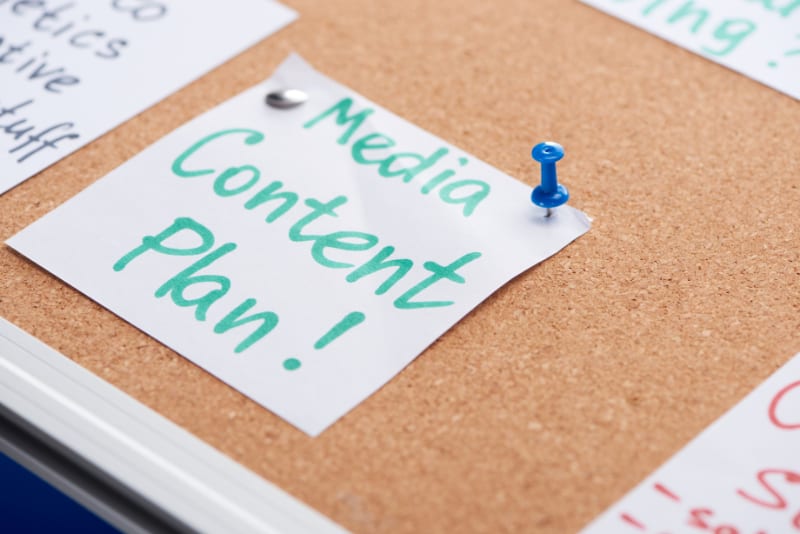This article will tell you what content mapping is and how to use content mapping to help your own business. As a component of the ever-evolving field of digital marketing, content marketing shares the same qualities with attracting prospects and sustaining them as customers.
Compared to other advertising methods, where it’s selling the company’s mission and services, content marketing enables customers to become invested first, by engaging with content that the customers would already seek out on their own terms. In other words, prospects are incentivized by content to further explore the associated company.
The educational marketing approach reinforces the business’s credibility, promotes brand awareness, and builds trust, all at once. Content mapping is a part of the content marketing process.
What is a Content Map?
- 1 What is a Content Map?
- 2 Content Map
- 3 Steps
- 4 Content Mapping Template
- 5 Frequently Asked Questions About Content Mapping
- 5.1 1. How is content mapping different from a regular content calendar?
- 5.2 2. What’s the difference between lifecycle stages and the traditional sales funnel in content mapping?
- 5.3 3. How often should I update my content map, and what triggers changes?
- 5.4 4. What tools do I need to create an effective content map, and are there free options?
- 5.5 5. How do I create accurate buyer personas if I’m a new business with limited customer data?
- 5.6 6. What’s the biggest mistake businesses make when implementing content mapping?
- 5.7 7. How can I measure the success of my content mapping strategy?
A content map sets the foundation for inbound marketing plans, as it accounts for timing of content delivery and tailoring it based on the needs and interests of prospects. The “mapping” terminology stems from seeing the bigger picture on how the content should be organized and formatted, based on consumer patterns.
Content Map
Benefits
Keyword Mapping
One of the benefits of using content mapping is the opportunity to map keywords. Relevant keywords are assigned to content pages.
By this implementation, it can analytically measure performance to then better assess optimization efforts on a content, page, and keyword basis. Each page would be guided with a purpose. Teams, from different departments, can see the bigger picture idea of how content is organized.
With a unified goal, pages won’t unintentionally duplicate in substance and dilute the quality of production.
Additionally, knowing how keywords are mapped allows for an efficient layout to structure internal linking. By linking relevant on-page content, it also optimizes the search engine.

Content Growing
One of the first steps to content mapping is to take a content audit, which will be discussed later on in this article. Knowing where the company current stands in content publications and plans empowers teams to creatively design new ways to approach content creation.
Lifecycle Stages versus Sales Funnel
Sales funnel traditionally only have awareness, interest, decision, and action. Lifecycle stages are through the buyer point of view. While it has overlapping beginning stages, lifecycle stages additionally includes customer retention.
By understanding how consumers generally operate, and the different types of stages they go through, content can be better mapped to meet their interests.
Awareness
In the awareness stage, prospects first learn of the company’s service. Whether through a Google search, a new post or ad on their social media feed, or by word of mouth, the customers are now aware of the business’s existence and services.
Interest
As the consumer’s interests increase, they slowly start getting invested into the brand. Whatever product of service they’re looking for, they included the company on their radar.
Decision
In deciding whether or not the business is the best one to commit to, the consumer starts inspecting. If they decide to make a well-intended, research decision, they’ll consider competitor’s brands and compare which one offers the most worthy deal.
Action
Then, the action stage ideally follows suit: the prospect formally becomes a customer! They commit to the company, confirm an order and actually buy an item! The business succeeded in earning a sale. But there is still one more stage.
Post-Purchase
After a single purchase, the customer may choose to part ways. The alternative option? The customer happily returns back to the same company to use their product or service again.
Here, the customer maintains their engagement with the company. In a way, the consumer individually repeats the decision and action stage. But, because they already made a single purchase, they qualify as a returning, and perhaps even a loyal, customer.

Steps
Buyer Persona
In the context of content mapping, identifying buyer personas is a commonly recommended way to narrow down the intended audience. It’s important to conduct buyer persona research. Remember that content marketing is most effective when it directly meets the interests of prospects.
In trying to understand potential customers more, buyer personas can be constructed based on general knowledge or data. For example, research can be built from contacts, interviews, surveys, and previous sales performances.
- Demographics: All the basic information surrounding an individual, including factors such as: age, location, gender, residence, income, background, identifiers, profession, etc.
- Goals: What does the customer want? Why do they want this product or service? What would be their incentive to use a certain type of service? What are their values?
- Concerns: What would be their concerns? Is it related to cost? Accessibility? Quality products? How common are these fears?
- Buying habits: Are they impulsive in their purchases? Based on their income, how much money do they budget to spend on additional expenses? Within the timeline of the sales funnel, how quick do they go from interest to purchase? What would they object to never paying for?
Content Assessment
To know what to do next, the company should conduct an assessment of the content that is already published. The catalog of all pre-existing content should include details such as titles, URLs, categories, types, conversions, quality, and word count.
Beyond that, the inventory should quantify and qualify topics – ones where they’ve been fleshed out to its fullest or others where they weren’t explained enough in detail.
Based on the content assessment, the business can see what they are already working with. Therefore, content mapping can account for what has performed the best or other angles to approach already published topics.

Types of Content
Depending on the lifecycle stage, different types of content should be used. There are many different formats that qualify as content.
Awareness
In the beginning stage, companies need to set themselves up to easily be discovered. Some appropriate types of content to use would be videos, blog posts, social media posts for eye-catching, quick impressions. For more time to explain a certain idea, buying guides, podcasts, and longer videos would be more fitting.
Interest
In the interest stage, you catch the prospect’s attention. Now, you want them to start getting invested by maintaining some form of engagement. Luckily, social media platforms integrated interactive content. Beyond just giving a simple like and comment, platforms like Instagram provide tools to implement direct links, voting polls, and Q&A boxes. Of course, social media platforms are notorious for quick, visually-driven excerpts of information so that’s always available. While it requires a sign up, a really good tool to develop interest is through an email newsletter.
Evaluation
At the evaluation stage, customers are considering whether the business’s services are really worth it and more importantly, how does it rank up with its competitors. Reviews, testimonials, landing pages, and case studies render that much needed feedback and reassurance.
Purchase
Sale pages display all the information relevant to the product; this is where reviews, sales, discount codes, images, and other related-items would go. In encouraging customers to confirm and lock in their order, FAQs get rid of any minor hesitation as it answers any last minute, small questions. If they’re not convinced yet, free trial sign-ups act as another reason they should commit to the product.
Post-purchase
After the customer solidifies a purchase, they can express their thoughts on their experiences through a survey. To incentivize them to return to use the service again, provide coupons and discounts. Better yet, ask them to sign up through an email newsletter, if they haven’t already, to access those cost incentives.
Marketing
After finalizing the buyer persona, assessing the content inventory, and determining what types of content to use, update the content map! Then, start using it, and occasionally adjusting it, in content marketing endeavors.

Content Mapping Template
While content mapping templates can be curated, other companies offer templates.
Alexa
Alexa, an Amazon analytics tools company, offers a Buyer Persona Template with an article guide. The PDF template includes demographics, professional role, values, challenges, buying decisions, sources and influences. It notes to fill out the Buyer Persona based on interviews, sales team perspectives, business data, social networks, or referencing competitors’ buyer personas.
They recommend using some of their internal tools to help with the process:
- Internal Audience Overlap Tool: Analyze who competitors target as their audience. The tool can also run a competitor keyword matrix, where they recommend other buyer keyword options
- Keyword Difficulty Tool: Keyword search for numbers regarding relevance, popularity, and competition
- SEO Audit Tool – Assess site’s SEO strategy and offers additional resources on how to fix pending issues
Alexa also offers a Content Audit Template. The catalog includes:
- Basic information: Title, publish date, URL, category, type of content, and conversion
- Engagement metrics: Page visits, bounce rates, internal links, number of comments, total number of social shares, number of shares on other media channels
- Content quality: Word length, uniqueness, timeliness, topic relevance, and overall quality
Search Engine Journal
In Search Engine Journal’s Content Audit Checklist, they offer a spreadsheet to organize: URL, author, team, production time, title, date, content type, goal, word count, comments and social shares. In the article, there is a checklist for goals, staleness, credible information, and performance assessment.
The author also recommends using external content analyzers, such as Google Analytics and SEMrush’s Content Audit, to audit content based on sitemap data.
Hubspot
Hubspot’s Content Mapping Template and User Guide comes at no cost. Their package offer includes a video course on buyer personas and lifecycle stages. It comes with a guide on how to use their content mapping template, with examples. Additionally, they provide bonus buyer persona templates.
For help with your content mapping strategy, contact the content creation experts at SEO Design Chicago today!
Frequently Asked Questions About Content Mapping
1. How is content mapping different from a regular content calendar?
Content mapping is a strategic framework that aligns specific content types with different stages of the buyer’s journey and customer personas, while a content calendar simply schedules when content will be published. Content mapping focuses on the “what” and “why” – determining which content formats (blog posts, videos, case studies) are most effective for prospects in awareness, interest, evaluation, purchase, and post-purchase stages. A content calendar focuses on the “when” – timing and frequency of publication. The most effective content strategies use both: content mapping to ensure strategic alignment and content calendars to maintain consistent publishing schedules.
2. What’s the difference between lifecycle stages and the traditional sales funnel in content mapping?
Traditional sales funnels typically include four stages: awareness, interest, decision, and action, focusing primarily on moving prospects toward a single purchase. Lifecycle stages take a broader, customer-centric view that includes a fifth stage: post-purchase. This additional stage recognizes that customer retention and repeat business are crucial for long-term success. Lifecycle stages consider the entire customer relationship, from initial discovery through becoming loyal, returning customers who may provide referrals and testimonials. This approach helps businesses create content that nurtures ongoing relationships rather than just closing one-time sales.
3. How often should I update my content map, and what triggers changes?
Review and update your content map quarterly, with major revisions annually or when significant business changes occur. Triggers for updates include: changes in buyer personas based on new customer data, shifts in business goals or target markets, introduction of new products or services, poor performance of content in specific lifecycle stages, competitive changes in your industry, or seasonal variations in customer behavior. Additionally, conduct content audits every 6 months to identify gaps, outdated information, or opportunities for improvement. Your content map should be a living document that evolves with your business and customer needs.
4. What tools do I need to create an effective content map, and are there free options?
You can start content mapping with basic tools like spreadsheets (Google Sheets or Excel) to organize content by lifecycle stage and persona. Free options include HubSpot’s Content Mapping Template, Google Analytics for content performance data, and social media platform insights for engagement metrics. More advanced tools include SEMrush or Ahrefs for keyword research, Alexa’s audience overlap tools, and dedicated content management platforms. However, the most important element isn’t the tool but the strategic thinking behind your map. Start simple with free templates and upgrade to paid tools as your content strategy becomes more sophisticated.
5. How do I create accurate buyer personas if I’m a new business with limited customer data?
Start with available research methods: conduct interviews with potential customers in your target market, survey friends or contacts who fit your ideal customer profile, analyze competitors’ social media followers and engagement, research industry reports and demographic studies, and create personas based on your business plan assumptions. Use social media groups and forums where your target audience gathers to understand their language, concerns, and interests. As you gain actual customers, continuously refine your personas with real data from sales conversations, customer feedback, website analytics, and post-purchase surveys. Initial personas based on research are better than no personas at all.
6. What’s the biggest mistake businesses make when implementing content mapping?
The most common mistake is creating content maps that are too broad or generic, trying to appeal to everyone instead of specific buyer personas and lifecycle stages. Other frequent errors include: mapping content based on what the business wants to say rather than what customers need to hear, focusing only on the top of the funnel (awareness) while neglecting evaluation and post-purchase content, creating beautiful maps but failing to actually use them for content creation decisions, and not conducting regular content audits to identify gaps and opportunities. Remember that content mapping is meant to guide strategic decisions, not just create documentation.
7. How can I measure the success of my content mapping strategy?
Track metrics specific to each lifecycle stage: awareness stage success through website traffic, social media reach, and brand mention increases; interest stage through email signups, social media engagement, and time spent on content; evaluation stage via content downloads, case study views, and sales-qualified leads; purchase stage through conversion rates and sales attribution; and post-purchase stage using customer retention rates, repeat purchases, and referral generation. Use tools like Google Analytics to track the customer journey and identify which content pieces are most effective at moving prospects between stages. Set baseline metrics before implementing your content map, then measure improvements over 3-6 month periods to assess strategic impact.




Contact Us today!